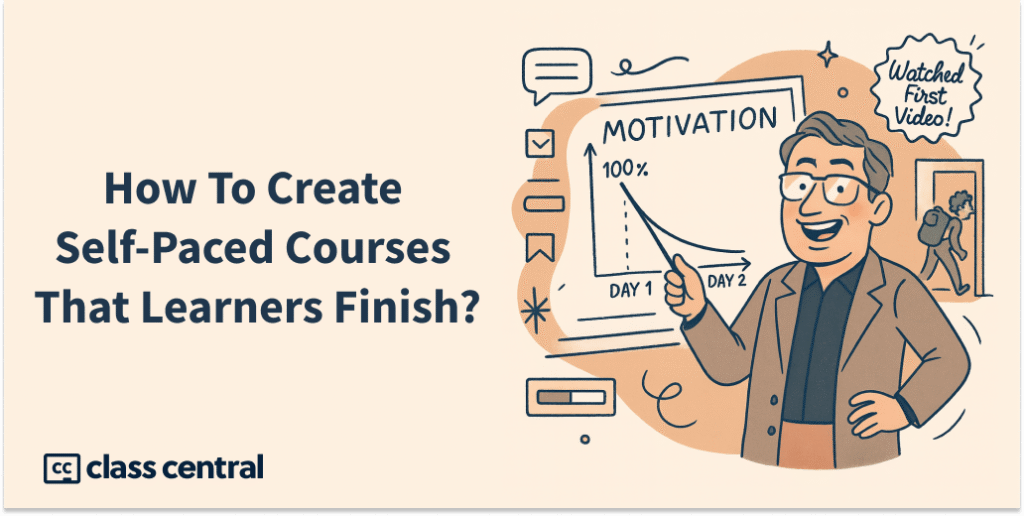

What is wrong with this training program?
As a content developer, I’d often ask myself this question. I helped ed-tech companies create training courses for their clients, but some courses were never finished.
Clients would sign their teams up for online training courses, hoping it would build their skills and confidence and boost their performance. The teams seemed excited and motivated at first, but a week in, and only a few would have completed them.
As course developers, we would put in a lot of effort; we even incorporated badges and certificates to motivate learners. Then why did just a handful earn them? In some cases, none of them got a certificate of completion. Our LMS (Learning Management System) data consistently revealed low completion numbers.
This has been a challenge for course creators because even when the intent to complete a course is there, the completion rate is less than 50%.
Clearly, motivation is still an unsolved problem, and you, as a course creator, can do something about it.
Factors that Hinder Motivation
Motivation is a learner’s intrinsic desire to be engaged in the learning process. This goes hand-in-hand with the student’s intentions, which are indications of their willingness to try and the amount of effort they plan to put toward completing the course.
The motivation to complete online courses tends to be higher when the course is aligned with a learner’s intentions. If a student intends to learn a skill that relates to their current or future career, they are more intrinsically motivated to complete the course.
But even if your course promises a career-making certification or practical skills, why is it falling flat (like ours were)? Here are some culprits I found.
Learners Feel Isolated
By design, eLearning consists of asynchronous courses offered on a SaaS (Software as a Service) type platform. This makes it easy for students to access and for course creators to monitor. Autonomy is one of its USPs (Unique Selling Proposition) — easy to access, anywhere, anytime.
This convenience, however, can lead to students feeling isolated. According to the American Psychological Association, isolation is a main factor in impaired executive function. Low executive function makes it harder to focus on tasks, stay organized, manage time, set goals, and complete tasks.
Social isolation in online education isn’t just uncomfortable, it directly lowers students’ intention to continue. Convenience and flexibility lose their impact when learners feel disconnected. To avoid motivation collapse, instructional design must intentionally build community elements that counter isolation.
– Social Science Research Network (SSRN)
Learners Lack Accountability
Online learning’s flexibility can lead to procrastination, especially when life gets in the way. Holding learners accountable for their course completion can be challenging. And without accountability, even motivated learners can lose momentum.

Online environments with no in-person touchpoints, a lack of supervision, and structure make it difficult for learners to stay on track.
Many online courses jumped on the gamification bandwagon of slapping on badges to signify milestones, hoping social accountability would be enough. But superficial badges awarded just for logging in or clicking through the content do not increase accountability or motivation, especially when learners realize they are meaningless.
Learners’ Goals Don’t Align with the Courses
In a 2020 PNAS (Proceedings of the National Academy of Sciences) study, researchers found that no one intervention worked for everyone. Why? Because learners tune out when the course isn’t aligned with their goals or context. If a course isn’t personally relevant, no amount of motivation will save it. Motivation needs meaning.
Students need to see a clear connection between what they’re learning and their personal or professional goals. If the course content doesn’t align, or worse, feels disconnected from real-world skills they can apply instantly, it’s easy for engagement to fade.
I’ve spent years learning, whether it was in university or online. I, too, took courses and dropped them in both settings. One reason was that they didn’t match my expectations.
If the title over-promises and under-delivers, learners will say goodbye. Misaligned expectations not only affect satisfaction but could exacerbate cognitive overload if learners are unprepared for the learning demands.
How to Make Learners Stick to Your Course?
We’ve established that it’s super easy for learners to lose motivation during a self-paced course, but with the right strategies, we can change that. Motivation isn’t just a mindset; it is something we can design and inculcate.
Build a System for Real-Time Interaction
To combat isolation, offer community. Every online course I have taken at a university has had a discussion board that enables students to have discussions with their peers. A recent course I took at Udemy also had a discussion board to interact with other students.
These boards don’t have to stick to introductions or Q&A. They can be used for case study discussions, personal resource sharing, or progress celebrations!
If you want to build a real sense of community on your platform, you can take it one step further — live group chat for active users to interact in real time.
A student’s sense of belonging improves academic outcomes, increases continuing enrollment, and is protective for mental health.
– Melissa Mangino of MIT’s Teaching + Learning Lab
Here are some more community-building ideas you can incorporate in your design:
- Shared Interest Channels: These micro-communities give students a space to connect around shared interests outside of the course.
- Social Shoutouts: These can be around great insights, helpful contributions, or progress, and build belonging and positive reinforcement.
- Create Space for Fun: Build a channel or a group for alternate conversations. Have a mid-week mood check, offer book/movie recommendations, and pave the way for candid interactions.
Real-time interaction builds connection, sharing, and empathy. Learners feel seen and supported, but even with a connection, it’s easy to fall behind when no one’s checking in.
That’s where collaboration comes in.
Build Accountability Through Collaboration

In self-paced learning, where there are no deadlines, it’s common for lofty goals to slip through the cracks. I’ve been there myself.
So, how do we fix it?
- Group Problem Solving: Students work together to analyze and develop solutions to real-world problems
- Role-Playing Scenarios: These are great for learning topics like customer service and leadership
- Peer Reviews: Students provide constructive feedback to their peers
- Discussion Groups: Offer students weekly, themed discussions they can take part in via video chat, forums, or voice notes.
Again, adding collaboration avenues along with a sense of community isn’t enough to keep learners engaged.
Design Relevant and Transformational Courses
Education is designed to transform people’s lives. To do that, it needs to be relevant to their individual goals. But how do you meet every learner’s individual goals? You give them opportunities to find the relevance in your design.
Transformative learning is sometimes called transformation learning, and focuses on the idea that learners can adjust their thinking based on new information.
That’s where the role of the learning designer comes in. To support transformative learning, designers must do more than just organize content. They must establish firm relevance.
This means grounding lessons in real-world scenarios, aligning activities with skill elevation, and prompting critical reflection that feels personal and purposeful. Basically, give them opportunities to turn your content into lessons.
In Bob Iger’s Business Strategy and Leadership course on MasterClass, he incorporates case studies and real-world scenarios from his own career with Disney. In Interactive 3D Clinical Skills: A Gamified Experience Specialization on Coursera, you’ll find courses that build clinical skills through 3D visuals, real-world cases, and interactive learning.
It’s this sense of relevance to the real world that boosts engagement and ultimately creates a transformative learning experience.
To Wrap Up
Online learning opens doors through its accessibility, but without the right environment, even the most motivated students can become disengaged. Motivation can be designed into the learning experience through community, accountability, and relevance.
Remember, you’re not just creating courses, you’re building learning ecosystems. At the end of the day, it’s not enough to hand someone a login. They need more than that, especially a reason to show up and keep the momentum going.
The post How to Create Online Courses That Learners (are Motivated to) Finish appeared first on The Report by Class Central.


![[2025] 100 Top FREE Coursera Courses of All Time](https://365daily.net/wp-content/uploads/2025/08/coursera-top-courses-DTsU4Q-768x384.png)



